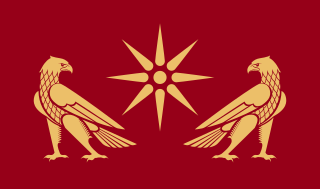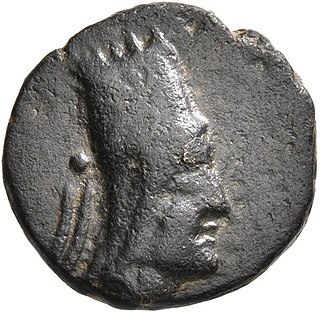This article concerns the period 169 BC – 160 BC.
This article concerns the period 199 BC – 190 BC.
Year 190 BC was a year of the pre-Julian Roman calendar. At the time it was known as the Year of the Consulship of Asiaticus and Laelius. The denomination 190 BC for this year has been used since the early medieval period, when the Anno Domini calendar era became the prevalent method in Europe for naming years.
Year 160 BC was a year of the pre-Julian Roman calendar. At the time it was known as the Year of the Consulship of Gallus and Cethegus and the Fourth Year of Houyuan. The denomination 160 BC for this year has been used since the early medieval period, when the Anno Domini calendar era became the prevalent method in Europe for naming years.
Year 163 BC was a year of the pre-Julian Roman calendar. At the time it was known as the Year of the Consulship of Gracchus and Thalna and the First Year of Houyuan (後元). The denomination 163 BC for this year has been used since the early medieval period, when the Anno Domini calendar era became the prevalent method in Europe for naming years.
Year 166 BC was a year of the pre-Julian Roman calendar. At the time it was known as the Year of the Consulship of Marcellus and Galus. The denomination 166 BC for this year has been used since the early medieval period, when the Anno Domini calendar era became the prevalent method in Europe for naming years.

Demetrius I, surnamed Soter, reigned as king (basileus) of the Hellenistic Seleucid Empire from November 162 to June 150 BC. Demetrius grew up in Rome as a hostage, but returned to Greek Syria and overthrew his young cousin Antiochus V Eupator and regent Lysias. Demetrius took control during a turbulent time of the Empire, and spent much of his time fighting off revolts and challenges to his power from threats such as Timarchus and Alexander Balas.

Antiochus IV Epiphanes was a Greek Hellenistic king who ruled the Seleucid Empire from 175 BC until his death in 164 BC. He was a son of King Antiochus III the Great. Originally named Mithradates, he assumed the name Antiochus after he ascended the throne. Notable events during Antiochus's reign include his near-conquest of Ptolemaic Egypt, his persecution of the Jews of Judea and Samaria, and the rebellion of the Jewish Maccabees.

Artaxias I was the founder of the Artaxiad dynasty of Armenia, ruling from 189 BC to 160 BC. Artaxias was a member of a branch of the Orontid dynasty, the earlier ruling dynasty of Armenia. He expanded his kingdom on all sides, consolidating the territory of Greater Armenia. He enacted a number of administrative reforms to order his expanded realm. He also founded a new capital in the central valley of the Araxes River called Artaxata (Artashat), which quickly grew into a major urban and commercial center. He was succeeded by his son Artavasdes I.

Artaxias II, also known as Artaxes II and Artashes was a prince of the Kingdom of Armenia, member of the Artaxiad dynasty and King of Armenia from 34 BC until 20 BC.

Zariadres was an Orontid ruler of Sophene.

Artavasdes I was the Artaxiad king of Armenia from approximately 160 BC to 115 BC. He was the son and successor of Artaxias I. Little is known about his reign. He is the subject of ancient Armenian folk traditions, which are recorded by later Armenian authors.

Sophene was a province of the ancient kingdom of Armenia, located in the south-west of the kingdom, and of the Roman Empire. The region lies in what is now southeastern Turkey.

The Artaxiad dynasty ruled the Kingdom of Armenia from 189 BC until their overthrow by the Romans in 12 AD. Their realm included Greater Armenia, Sophene and intermittently Lesser Armenia and parts of Mesopotamia. Their main enemies were the Romans, the Seleucids and the Parthians, against whom the Armenians conducted multiple wars.

Tigranes I was an Artaxiad king of Armenia at the end of the 2nd and the beginning of the 1st century BC. Few records have survived about his and his predecessor Artavasdes I's reign, which has led to some confusion. Some modern scholars have doubted that such a king reigned at all. Other historians, such as Hakob Manandian, David Marshall Lang and Rouben Paul Adalian consider him a real figure but differ or are uncertain on the exact dates of his reign. Although it has been proposed that Tigranes I reigned from 123 BC to 96 BC, this view has been criticized. Another suggestion is that Tigranes I ruled in 120 BC - 95 BC and this has been recently corroborated by historian Christian Marek.
The Orontid dynasty, also known as the Eruandids or Eruandunis, ruled the Satrapy of Armenia until 330 BC and the Kingdom of Armenia from 321 BC to 200 BC. The Orontids ruled first as client kings or satraps of the Achaemenid Empire and after the collapse of the Achaemenid Empire established an independent kingdom. Later, a branch of the Orontids ruled as kings of Sophene and Commagene. They are the first of the three royal dynasties that successively ruled the antiquity-era Kingdom of Armenia.

Cappadocia was a province of the Roman Empire in Anatolia, with its capital at Caesarea. It was established in 17 AD by the Emperor Tiberius, following the death of Cappadocia's last king, Archelaus.

Orontes IV was the son of King Arsames and is recorded as ruling Armenia from inscriptions found at the historic capital of the Orontid dynasty, Armavir. He was the founder of the city of Yervandashat. In his reign the religious site of Bagaran was founded. Large bronze statues in the Hellenistic style of the gods, Zeus (Aramazd), Artemis (Anahit) and Herakles (Vahagn) were brought there and set up in temples dedicated to them. He is also said to have founded a shrine at Armavir dedicated to Apollo (Mithra), a golden statue of four horses pulling a chariot with Apollo as god of the Sun. This was later destroyed by the Sassanid Persian army in the 4th century AD.

Artashat, Hellenized as Artaxata and Artaxiasata (Ἀρταξιάσατα), was a major city and commercial center of ancient Armenia which served as the capital of the Kingdom of Armenia from its founding in 176 BC to 120 AD, with some interruptions. It was founded during reign of King Artaxias I (Artashes), the founder of the Artaxiad dynasty. Its ruins are located in the Ararat Province of modern-day Armenia, on the left bank of the Araks River, at the site of the monastery of Khor Virap. It was destroyed and rebuilt several times from the 1st to the 5th centuries AD, before finally being abandoned.











